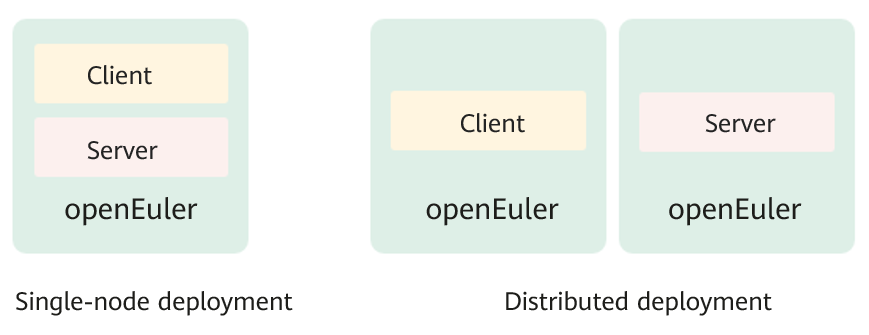Installation and Deployment
This chapter describes how to install and deploy A-Tune.
Software and Hardware Requirements
Hardware Requirement
- Huawei Kunpeng 920 processor
Software Requirement
- OS: openEuler 20.03 LTS
Environment Preparation
For details about installing an openEuler OS, see the openEuler 20.03 LTS Installation Guide.
A-Tune Installation
This section describes the installation modes and methods of the A-Tune.
Installation Modes
A-Tune can be installed in single-node or distributed mode.
Single-node mode
The client and server are installed on the same system.
Distributed mode
The client and server are installed on different systems.
The installation modes are as follows:

Installation Procedure
To install the A-Tune, perform the following steps:
Mount an openEuler ISO file.
mount openEuler-20.03-LTS-aarch64-dvd.iso /mntConfigure the local yum source.
vim /etc/yum.repos.d/local.repoThe configured contents are as follows:
[local] name=local baseurl=file:///mnt gpgcheck=1 enabled=1Import the GPG public key of the RPM digital signature to the system.
rpm --import /mnt/RPM-GPG-KEY-openEulerInstall an A-Tune server.
 NOTE:
In this step, both the server and client software packages are installed. For the single-node deployment, skip Step 5.
NOTE:
In this step, both the server and client software packages are installed. For the single-node deployment, skip Step 5.yum install atune -yFor a distributed mode, install an A-Tune client.
yum install atune-client -yCheck whether the installation is successful.
$ rpm -qa | grep atune atune-client-xxx atune-db-xxx atune-xxxIf the preceding information is displayed, the installation is successful.
A-Tune Deployment
This section describes how to configure and deploy A-Tune.
Overview
The configuration items in the A-Tune configuration file /etc/atuned/atuned.cnf are described as follows:
A-Tune service startup configuration
You can modify the parameter value as required.
protocol: Protocol used by the gRPC service. The value can be unix or tcp. unix indicates the local socket communication mode, and tcp indicates the socket listening port mode. The default value is unix.
address: Listening IP address of the gRPC service. The default value is unix socket. If the gRPC service is deployed in distributed mode, change the value to the listening IP address.
port: Listening port of the gRPC server. The value ranges from 0 to 65535. If protocol is set to unix, you do not need to set this parameter.
rest_port: Listening port of the system REST service. The value ranges from 0 to 65535.
sample_num: Number of samples collected when the system executes the analysis process.
System information
System is the parameter information required for system optimization. You must modify the parameter information according to the actual situation.
disk: Disk information to be collected during the analysis process or specified disk during disk optimization.
network: NIC information to be collected during the analysis process or specified NIC during NIC optimization.
user: User name used for ulimit optimization. Currently, only the user root is supported.
tls: SSL/TLS certificate verification for the gRPC and HTTP services of A-Tune. This is disabled by default. After TLS is enabled, you need to set the following environment variables before running the atune-adm command to communicate with the server:
- export ATUNE_TLS=yes
- export ATUNE_CLICERT=<Client certificate path>
tlsservercertfile: path of the gPRC server certificate.
tlsserverkeyfile: gPRC server key path.
tlshttpcertfile: HTTP server certificate path.
tlshttpkeyfile: HTTP server key path.
tlshttpcacertfile: CA certificate path of the HTTP server.
Log information
Change the log path and level based on the site requirements. By default, the log information is stored in /var/log/messages.
Monitor information
Hardware information that is collected by default when the system is started.
Example
#################################### server ###############################
# atuned config
[server]
# the protocol grpc server running on
# ranges: unix or tcp
protocol = unix
# the address that the grpc server to bind to
# default is unix socket /var/run/atuned/atuned.sock
# ranges: /var/run/atuned/atuned.sock or ip
address = /var/run/atuned/atuned.sock
# the atuned grpc listening port, default is 60001
# the port can be set between 0 to 65535 which not be used
port = 60001
# the rest service listening port, default is 8383
# the port can be set between 0 to 65535 which not be used
rest_port = 8383
# when run analysis command, the numbers of collected data.
# default is 20
sample_num = 20
# Enable gRPC and http server authentication SSL/TLS
# default is false
# tls = true
# tlsservercertfile = /etc/atuned/server.pem
# tlsserverkeyfile = /etc/atuned/server.key
# tlshttpcertfile = /etc/atuned/http/server.pem
# tlshttpkeyfile = /etc/atuned/http/server.key
# tlshttpcacertfile = /etc/atuned/http/cacert.pem
#################################### log ###############################
# Either "debug", "info", "warn", "error", "critical", default is "info"
level = info
#################################### monitor ###############################
[monitor]
# With the module and format of the MPI, the format is {module}_{purpose}
# The module is Either "mem", "net", "cpu", "storage"
# The purpose is "topo"
module = mem_topo, cpu_topo
#################################### system ###############################
# you can add arbitrary key-value here, just like key = value
# you can use the key in the profile
[system]
# the disk to be analysis
disk = sda
# the network to be analysis
network = enp189s0f0
user = root
Starting A-Tune
After the A-Tune is installed, you need to start the A-Tune service.
Start the atuned service.
systemctl start atunedTo query the status of the atuned service, run the following command:
systemctl status atunedIf the following information is displayed, the service is started successfully:











